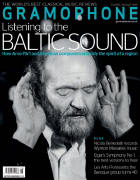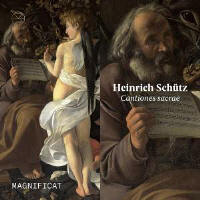Texte paru dans: / Appeared in: |
|
|
Outil de traduction (Trčs approximatif) |
|
|
Reviewer:
Fabrice Fitch Schütz’s Cantiones sacrae (1625) is not the easiest collection to situate within his output. The combination of Latin texts, consistently four-voice and mostly a cappella scoring, small scale and judicious dissonance treatment is most unusual. This may account for the widely divergent approaches of the three most recent complete recordings: Weser-Renaissance Bremen (1996) present the a cappella pieces just so; the Dresdner Kammerchor (2012) have multiple voices to a part; and this new offering from Magnificat has solo voices consistently accompanied by a variety of continuo instruments. That Schütz acquiesced to the publication of a fifth partbook for the continuo shows that he would not have objected to Magnificat’s choice. Whether some pieces are nonetheless better served by having just voices is a different question (the Pater noster comes to mind); Weser-Renaissance’s set allows us to judge the matter on a caseby-case basis – a most rewarding exercise, which space prevents me from doing here. Another observation to arise out of sustained listening is Schütz’s astonishing ability to pare technique and expression down to essentials. A variety of scoring options would alleviate a certain feeling of sameness. This is hardly the composer’s fault, since he wouldn’t have expected the pieces to be played straight through; but if it’s a trap for the modern performer, all three ensembles fall into it to some extent. For their part, Magnificat’s use of organ and violone makes it harder for the singers to inflect the pulse, as the music’s Italianate accents seem to require. Although those of Wesertalks to ... David Skinner The director of Alamire discusses recording polychoral motets by Hieronymus Praetorius What exposure to polychoral music did Praetorius have in north Germany? The so-called cori spezzati (separated choirs) had its origins in Italy in the 1540s with composers such as Adrian Willaert, who sought to make use of the opposing choir lofts in St Mark’s Basilica in Venice. The style was at its peak in the 1580s and ’90s while Giovanni Gabrieli was organist there, although by then other European composers were likewise mastering the technique. In 1584 the German composer Hans Leo Hassler travelled to Venice and learnt the polychoral style directly from the Italians. Hassler returned to Germany in 1585 and met Hieronymus Praetorius and Michael Praetorius (no relation to Hieronymus) the following year. This is thought to be Hieronymus’s only contact with other polychoral masters, and he went on to publish some 100 Latin and German motets for ive to 20 parts between 1599 and 1625. Renaissance shade them from a vocal standpoint, these are very fine singers without doubt (the famous Cantate Domino is pleasingly warm and festive); and yet one senses a reluctance to venture out of their comfort zone and inhabit the unsettling hybrid territory that Schütz has mapped out for himself and his performers. One might say the same of the continuo group, which rarely challenges the singers’ primacy. Overall I have come to warm to Weser-Renaissance’s approach; but again, comparing the two sets is a good way to understand how elusive Schütz’s Op 4 proves to be in performance. |
|




